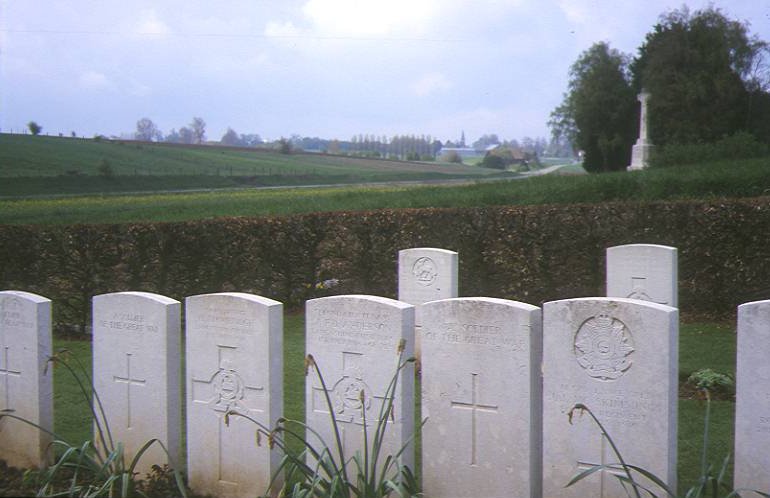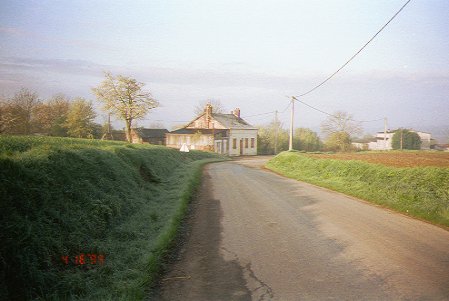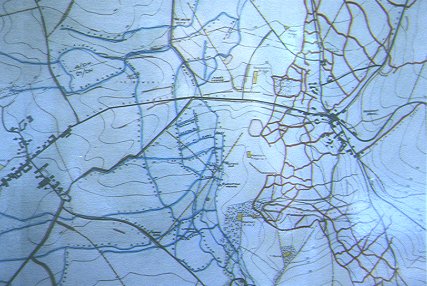| Views
of Auchonvillers
 A view of the village from the cemetery at the Sunken Lane
A view of the village from the cemetery at the Sunken Lane
 A panorama from the Sunken Lane to the German front line
A panorama from the Sunken Lane to the German front line
 Station buildings on the metre gauge line at Auchonvillers
Station buildings on the metre gauge line at Auchonvillers
 Trench map, 1916, Auchonvillers and Beaumont Hamel
Trench map, 1916, Auchonvillers and Beaumont Hamel
 Military cemetery at Auchonvillers
Military cemetery at Auchonvillers

Looking west from
Beaumont Hamel cemetery near the Sunken Lane. The village of Auchonvillers
runs along the furthest ridge. 10 rue Delattre is behind the low grey building
in the middle. The closer left hand ridge hides the communication trench
called Second Avenue which descends from the south end of the village.
The white cross is the 8th Argyll and Sutherland Highlanders memorial
and is very close to the site of their battalion Headquarters on 13th November
1916. This was on the opposite side of the farm track at the bottom of
the lane. The cemetery holds men from battalions of the 29th Division who
were killed on 1st July 1916, in particular of the 1st Lancashire
Fusiliers who attacked from both the Sunken Lane and the British front
line at zero hour on that morning. Many were shot down by concentrated
machine gun fire in front of the lane and only fifty or so got as far as
the area where the cemetery now is. During the day the battalion lost 8
officers and 156 other ranks and not a single man got into the German positions.
The battalions of this regiment were awarded eighteen Victoria Crosses
during this war.
Top

Panorama looking
from the Sunken Lane (left), across no-mans-land and the Beaumont Hamel
cemetery (center right) to the German front line (trees right).
Top

Station buildings
at Auchonvillers. These served the French civilian metre gauge line which
was still running through to Albert in 1915, although trains only ran infrequently
and at night. Much of the ammunition for the Somme offensive was brought
up on this line. The offloaded shells were then carried to the gun positions
by fatigue parties. When the British arrived in July 1915 they used the
station as a dressing station. This was later moved to a large farm at
the western end of the village. The railway is now gone and the station
buildings are used as a house. Comparision with aerial photographs suggests
that it is the original pre-1914 building.
Top

Modern map, compiled
from original trench maps, showing positions in 1916. British trenches
in blue, German trenches in red. Auchonvillers is on the left hand side
of the map and 10 Rue Delattre is on the left of the road running northwest
to the crossroads in the centre of the village. Beaumont Hamel is just
behind the German trenches. The Hawthorn Ridge mine crater is just to the
right of centre, below the pale green rectangle which is the Beaumont Hamel
cemetery. Newfoundland Park is the area between the trenches at the bottom
of the map.
Top

Auchonvilliers military
cemetery. Whereas the Beaumont Hamel cemetery is situated on the front
line, close to where the soldiers were killed, this cemetery contains many
men who were evacuated and died of wounds. The "Red Barn" dressing
station is on the right hand side out of the picture. The cemetery also
contains the graves of men killed during the routine of trench warfare
by artillery and trench mortars. A number of men from 252 Tunnelling Company,
Royal Engineers are buried here. They were killed by German countermines
in the vicious mine war that took place under Redan Ridge in 1915 and 1916.
Other casualties include men of the New Zealand, Royal Naval, 12th and
17th Divisions who were killed nearby in 1918.
Top
Back
Top
|